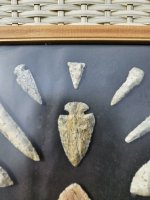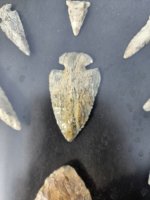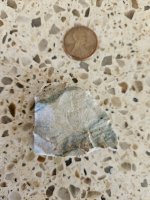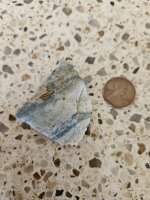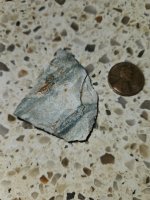If you have Attica Chert / Indiana Green Flint relics, let's see them please.
I have a number of Attica Chert / Indiana Green Flint relics found over the years. Like many others, the lack of mold bard plowing is bringing less and less points to the surface. I don't think I have found an Attica Chert / Indiana Green Flint in a few years now.
I have found maybe 10 to 15 nicely made Attica Chert / Indiana Green Flint relics which I will pull out and post.
At some Central States Archaeological Societies shows, especially in Indiana, you will see collections of Attica Chert / Indiana Green Flint of collectors who live close to the Warren County area, and some who like the flint for the color and/or rarity.
In Tony DeRegnaucourt book "Prehistoric Cert Types of the Midwest", he states: The name Attica was proposed by Winters (1969) after a small town of that name in Warren County, Indiana, near an important outcrop of the chert. The green variety known as Indiana Green is known to outcrop near the small town of Independence in Warren County, Indiana. This type is also known to outcrop along the Wabash River and Sugar Creek, hence those names.
Prehistoric Geographical Distribution: Found all over northern and Central Indiana primarily along the Wabash, Mississinawa, and Salamonie Rivers. This chert type is also found in northeastern Ilinois, extreme southern Michigan, Western Ohio and rarely along the Ohio River in extreme northern Kentucky.
Prehistoric Utilization: Within its local outcropping, extending to about a 30-mile radius, all prehistoric periods from Paleo-Indian to Late Prehistoric are represented by Attica/Indiana Green chert. However, after travelling in over 30 miles in any direction, especially along the Wabash River, the chert is found almost exclusively in Paleo-Indian and Early Archaic context. In fact, once Attica chert cross the state lines of Ohio, Michigan, Illinois, or Kentucky, only Paleo-Indian or Early Archaic contexts are known to the complete absence of later cultures. Thus, even the debitage of this chert is very diagnostic when it reaches the farthest Distibution. For example, in Ohio all Arttica/Indiana Green chert found is early Archaic. A paleo-Indian artifact rarely is found at the extreame range. Curiously, even during the Early Archaic Period, usage varies tremendously. It is common to see MacCorkly and Kanawha points of the Bifurcated Tradition make f Attica/Indiana Green chert, but outside of the core area of the outcropping, on never sees a LeCroy or St Albans bifurecated point made of this material. The maximum range for this chert appears to be about 130 miles in radius from its outcropping in northwestern Indiana.
page 96-97


This Attica Chert / Indiana Green Flint Hardin point was found in Hancock County Indiana in 2000.

I have a number of Attica Chert / Indiana Green Flint relics found over the years. Like many others, the lack of mold bard plowing is bringing less and less points to the surface. I don't think I have found an Attica Chert / Indiana Green Flint in a few years now.
I have found maybe 10 to 15 nicely made Attica Chert / Indiana Green Flint relics which I will pull out and post.
At some Central States Archaeological Societies shows, especially in Indiana, you will see collections of Attica Chert / Indiana Green Flint of collectors who live close to the Warren County area, and some who like the flint for the color and/or rarity.
In Tony DeRegnaucourt book "Prehistoric Cert Types of the Midwest", he states: The name Attica was proposed by Winters (1969) after a small town of that name in Warren County, Indiana, near an important outcrop of the chert. The green variety known as Indiana Green is known to outcrop near the small town of Independence in Warren County, Indiana. This type is also known to outcrop along the Wabash River and Sugar Creek, hence those names.
Prehistoric Geographical Distribution: Found all over northern and Central Indiana primarily along the Wabash, Mississinawa, and Salamonie Rivers. This chert type is also found in northeastern Ilinois, extreme southern Michigan, Western Ohio and rarely along the Ohio River in extreme northern Kentucky.
Prehistoric Utilization: Within its local outcropping, extending to about a 30-mile radius, all prehistoric periods from Paleo-Indian to Late Prehistoric are represented by Attica/Indiana Green chert. However, after travelling in over 30 miles in any direction, especially along the Wabash River, the chert is found almost exclusively in Paleo-Indian and Early Archaic context. In fact, once Attica chert cross the state lines of Ohio, Michigan, Illinois, or Kentucky, only Paleo-Indian or Early Archaic contexts are known to the complete absence of later cultures. Thus, even the debitage of this chert is very diagnostic when it reaches the farthest Distibution. For example, in Ohio all Arttica/Indiana Green chert found is early Archaic. A paleo-Indian artifact rarely is found at the extreame range. Curiously, even during the Early Archaic Period, usage varies tremendously. It is common to see MacCorkly and Kanawha points of the Bifurcated Tradition make f Attica/Indiana Green chert, but outside of the core area of the outcropping, on never sees a LeCroy or St Albans bifurecated point made of this material. The maximum range for this chert appears to be about 130 miles in radius from its outcropping in northwestern Indiana.
page 96-97
This Attica Chert / Indiana Green Flint Hardin point was found in Hancock County Indiana in 2000.
Amazon Forum Fav 👍
Upvote
18



